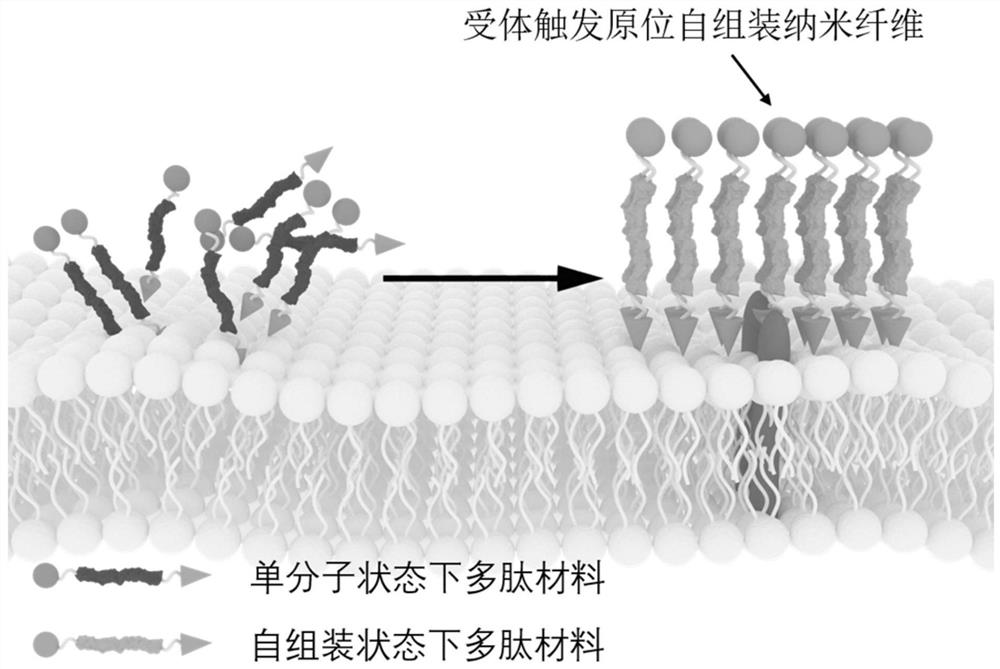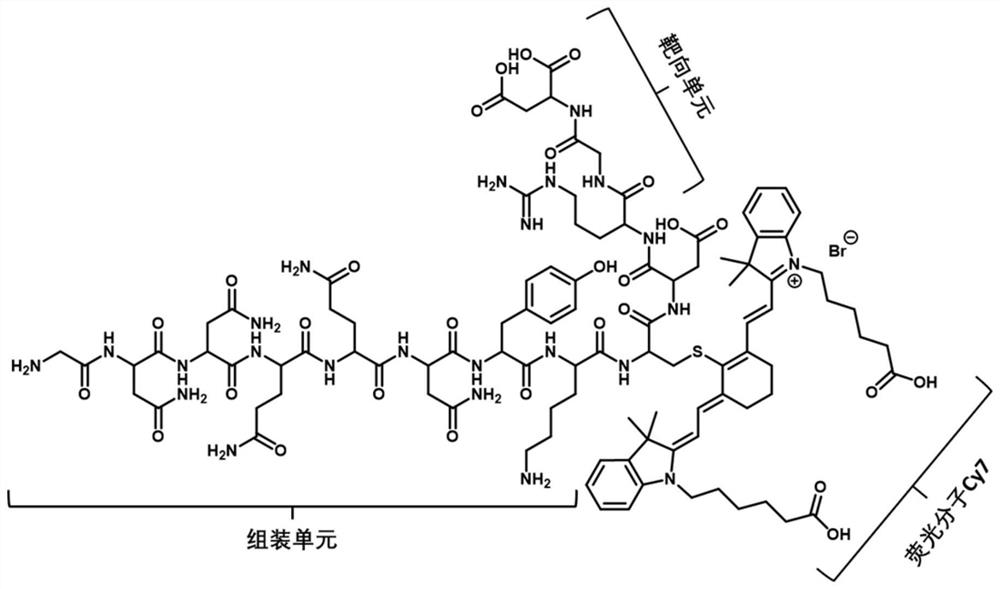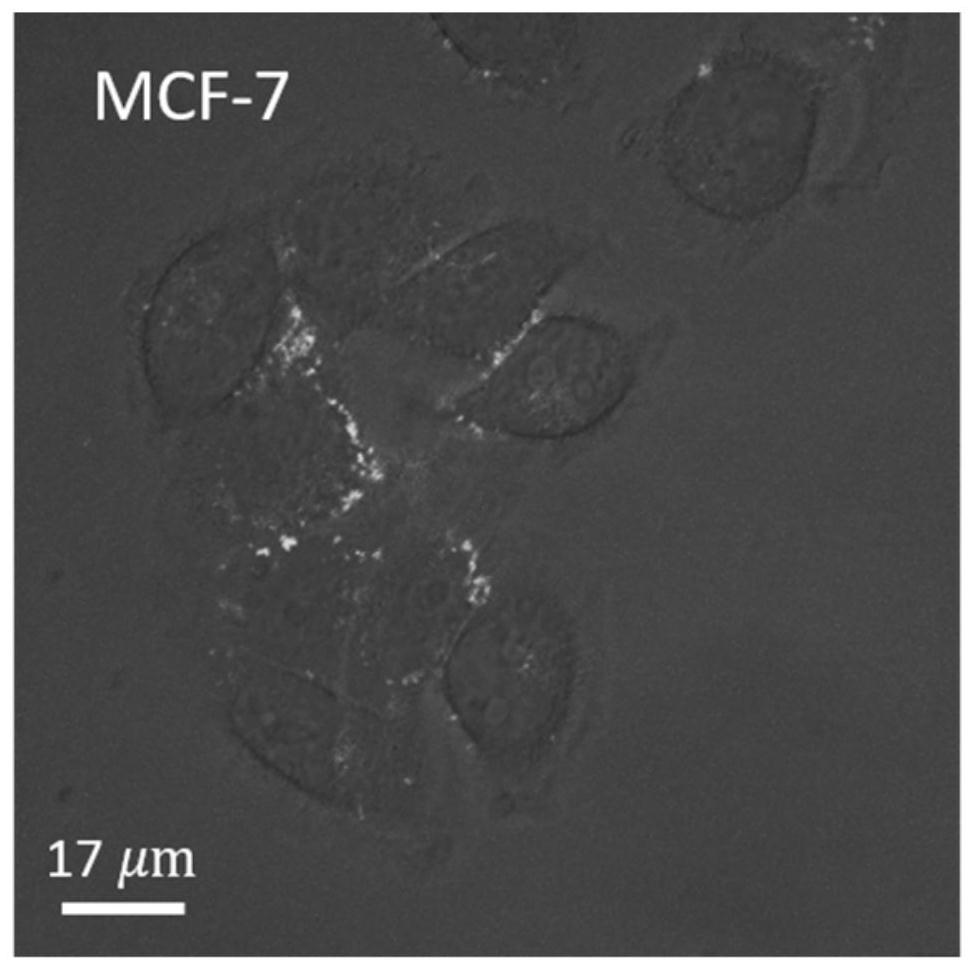Polypeptide imaging probe as well as preparation method and application thereof
A technology of imaging probes and peptide segments, which is applied in the fields of peptide preparation, fusion peptides, chemical instruments and methods, etc., can solve the problems of inefficient access, limited application scope of imaging probes, and large molecular weight of probes, and achieves structural Simple, good aggregation retention, and the effect of enhancing the imaging signal-to-noise ratio
- Summary
- Abstract
- Description
- Claims
- Application Information
AI Technical Summary
Problems solved by technology
Method used
Image
Examples
Embodiment 1
[0073]Example 1 Design, Synthesis and Function of Polypeptide Imaging Probe αvβ3-CY
[0074]In this example, the polypeptide imaging probe αvβ3-CY is designed with αvβ3 as a targeted receptor, and the polypeptide imaging probe αvβ3-cyp is made of a peptide, soluble self-contained peptide, and near-infrared fluorescent molecule Cy. Near infrared fluorescent molecule CY is attached to the side chain of polypeptides by cysteine (C), and molecular structural formula isfigure 2 As shown, the amino acid sequence is shown in SEQ ID NO: 14;
[0075]SEQ ID NO: 14: GnnqqNykc (CY7) DRGD.
[0076]The synthesis steps are as follows:
[0077](1) Weighing the resin and invested in the polypeptide solid phase synthesis, adding an appropriate amount of DMF swelling for 4 h; extracting the DMF, perform FMOC to protect by FMOC deprotectant, shake the bed mixed 15 min; extract the FMOC deprotectant, Add DMF, DCM alternately washing the resin 3 times, take a small amount of resin (about 10) from the polypeptide s...
Embodiment 2
[0087]Example 2 Design, Synthesis and Function of Polypeptide Imaging Probes EPCAM-CY
[0088]In this embodiment, the polypeptide imaging probe EPCAM-CY is designed with EPCAM, the polypeptide imaging probe EPCAM-CY consists of an EPCAM receptor recognition peptide, a soluble self-contained peptide and a near-infrared fluorescent molecule Cy. Near infrared fluorescent molecule CY is attached to the side chain of polypeptides by cysteine (C), and molecular structural formula isFigure 5 As shown, amino acid sequences are shown in SEQID NO: 15;
[0089]SEQ ID NO: 15: gnnqqNykc (CY7) Dyevhtyyld.
[0090]Synthesis method is shown in Example 1.
[0091]Around 10 respectively5Epithelial cell adhesion molecule EPCAM high expression of breast cancer cell line MCF-7 and 1051 ml of 20 μm polypeptide imaging probe EPCAM-CY, 5% CO, epstel, umbilical vein endothelial cell line, ephemeric cell adhesion molecule epcam, is added to HUVEC.2The cell incubator was incubated for 1 h, and the cells were observed u...
Embodiment 3
[0096]Example 3 Design, Synthesis and Function of Polypeptide Imaging Probe αvβ3-NBD
[0097]Compared to near-infrared fluorescent molecules, the biographical imaging effect of short-wavelength fluorescent molecules is slightly insufficient, but the cell imaging effect is more stable, and it is not easy to quench. This example employs a fluorescence imaging of the cellular surface with a molecule having a aggregated induced light-emitting effect of an aggregation induced light-emitting effect, having an exemption, signal-to-noise ratio, and can qualitatively characterize the expression of the cell surface receptor.
[0098]The molecular structure formula of the polypeptide imaging probe αvβ3-NBD in this embodiment is likeFigure 8 As shown, amino acid sequences are shown in SEQ ID NO: 16, wherein X is Fmoc aminopteraenic acid;
[0099]SEQ ID NO: 16: NBD-X-gnnqqNyRGD.
[0100]Synthesis Methods Example 1, different in the case where the NBD is counted: FMOC is removed after the last amino acid of ...
PUM
 Login to View More
Login to View More Abstract
Description
Claims
Application Information
 Login to View More
Login to View More - R&D
- Intellectual Property
- Life Sciences
- Materials
- Tech Scout
- Unparalleled Data Quality
- Higher Quality Content
- 60% Fewer Hallucinations
Browse by: Latest US Patents, China's latest patents, Technical Efficacy Thesaurus, Application Domain, Technology Topic, Popular Technical Reports.
© 2025 PatSnap. All rights reserved.Legal|Privacy policy|Modern Slavery Act Transparency Statement|Sitemap|About US| Contact US: help@patsnap.com



